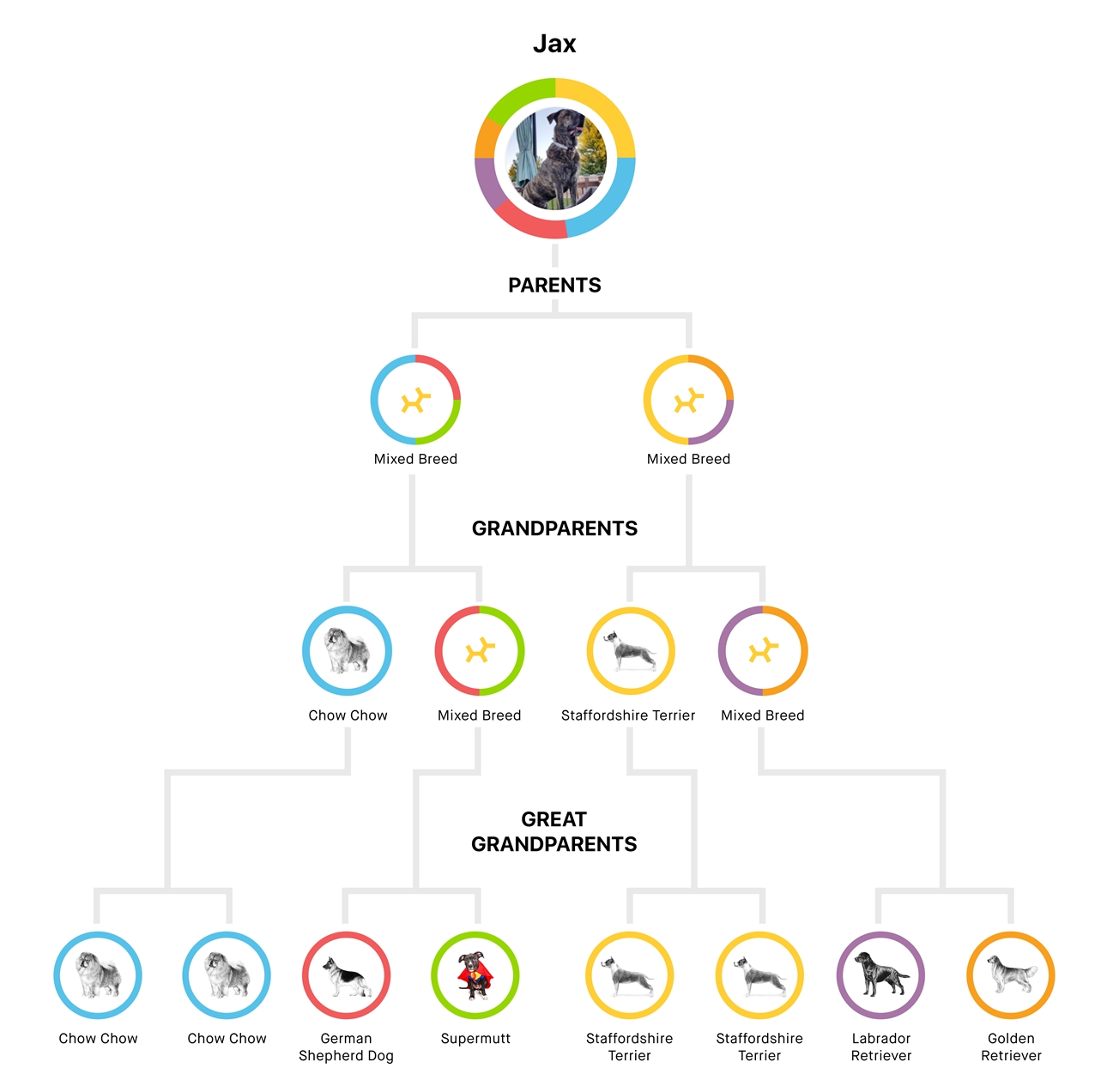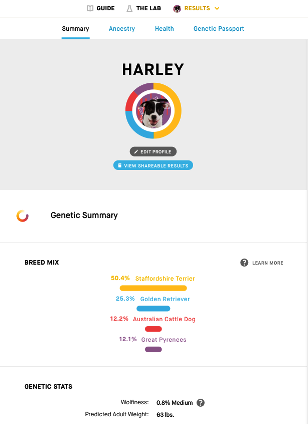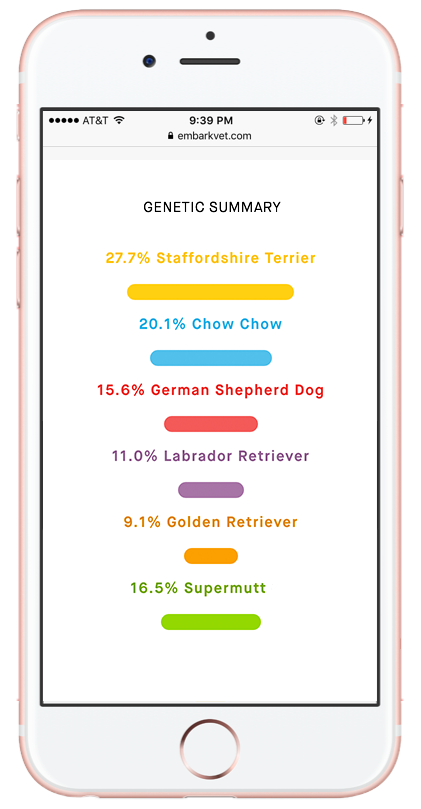Barks Blog
The Impact of Canine DNA Testing: Mapping the Future

In May 2016, Embark launched its comprehensive pet genetic test in partnership with the Cornell University College of Veterinary Medicine.
According to Embark’s website, the test will track “over 200,000 genetic markers, offering ancestry analysis as well as an extensive overview of both genetic disease risk and heritable traits, allowing users to understand their dog’s health, plan for his future and provide the best personalized care possible.”
Embark further states that “four out of 10 dogs will suffer from inherited diseases,” and that the test, more than just a breed test, will examine a dog’s DNA “to screen for over 160 genetic diseases, including multi-drug sensitivity, degenerative myelopathy, dilated cardiomyopathy, Progressive Retinal Atrophy blindness, and exercise-induced collapse.”
Many conditions — such as glaucoma, heart disease, and spinal cord disease — can occur later in life, but “by knowing what to look for, you can get treatment started as early as possible,” Embark says.
Inherited Diseases
Ryan Boyko founded Embark after a decade spent using Big Data* to tackle issues in public health, ecology, and industry. He traveled all over the world collecting canine samples. Now, via the test, his aim is to improve the lives of dogs worldwide. With “over 77 million pet dogs in the US and an average cost of dog ownership of $19,692,” Embark says the “time is right” for this test.
BARKS: What has the test revealed to you about the genetic history of the dog in terms of its ancestry, specifically in terms of geography, and also timing (as in how long have dogs cooperated with humans)?
Ryan Boyko: Our research [with brother, Adam] has contributed to the growing consensus that dogs are from Asia and has pointed to a Central Asian origin about 15,000 years ago. Though our DNA test only launched [six] months ago, we’ve started getting samples from village dogs across the world – just [recently] we gave results to dogs from the Americas, Africa, and Asia. We’re hopeful that these samples, over time as we collect more of them, will continue to help unravel the origins and early history of the dog – stay tuned!
Why Genetic Testing?
BARKS: What is the relevance of a genetic test to the average dog owner?
RB: Americans spend on average over $400 per dog in veterinary expenses each year, and this amount increases as a dog gets older. We know that the average lifetime cost of vet bills is $9,420.
The Embark DNA test results help you prepare in advance for numerous possible genetic health conditions, allowing you to take preventative steps to avoid costly treatments later on, and reducing the likelihood you’ll face expensive bills for avoidable clinical or genetic tests later on if symptoms of these conditions develop in your dog. Our genetic tests empower dog owners to connect with their pets on a deeper level and allow them to provide the best care possible.
BARKS: The cost of the test is $199. That might be considered a little expensive for the average dog owner. What would be the advantages for them in making the investment?
RB: Embark was created by the world leaders in dog genetics. The Embark test is the only comprehensive test on the market, providing you results for over 160 genetic health conditions, the most scientifically accurate breed identification of any test (based on more than 100 times as much genetic information as other tests), and so much more.
That price also covers peace of mind: knowing if your dog is at risk for those 160+ genetic diseases or not. Having an accurate knowledge of your dog’s breed also helps you and your veterinarian know other diseases that may be more likely to appear during your dog’s life.
We’re developing several one-of-a-kind analyses as well. For example, our genetic age (based on several factors including size genes and inbreeding) is a much more accurate way of determining where in your dog’s life course they are. This can help guide decisions about what food to feed your dog and what screenings to get. Simply put, we go above and beyond for each dog we service.
We want to know it all and, as a result, provide our customers with the knowledge to provide the best care for their dog, which we believe will ultimately save money as well as doggy lives.

The Veterinarian’s Perspective
BARKS: How receptive have veterinarians been to the results of the test so far?
RB: Our vet report, included with [the] Embark DNA kit, was designed by vets. It allows you to share key information with your vet to give your dog the best care possible. The response has been very positive – our goal is to give vets more information to help them better care for their patients. Many vet practices have approached us with interest in offering it to their patients.
BARKS: Are vets likely to be wary of the fact that potential prevention rather than cure may impact their revenues? What effect might the test have on the veterinary care of any individual animal in that sense? Will it perhaps just go in a different direction, rather than vets “losing out?”
RB: We don’t see it that way, and we don’t think vets do either. Our goal at Embark is to help your dog live a long, healthy life. We provide vets with a comprehensive report to better serve the needs of their furry patients.
We’re confident that vets care most about their patients’ health and lives, and that we can work with veterinarians to make this a win-win-win-win proposition for us, them, their clients, and their clients’ dogs.
Future Health Issues
BARKS: What impact can the test have on assessing the dog’s health and/or future health issues? There are reports of it being used to test for cancer or hip dysplasia amongst others. Can you elaborate on what conditions or diseases the test can screen for, and does it mean that owners can be “pre-warned” and therefore take preventative measures (with the help of their vet)?
RB: We strive to make your dog’s healthspan equal his/her lifespan – to ensure your dog remains able to go for long walks, play fetch, and roll in their favorite puddle for as long as possible! You can extend your dog’s healthspan by testing for genetic diseases that occur later in life including glaucoma, degenerative myelopathy, and dilated cardiomyopathy, three of the most common adult onset diseases in dogs.
By knowing what to look for, you and your vet can begin treatment as early as possible.
Many of the most common things we identify as health risks are easily preventable or treatable. We work to give you and your vet enough information to be on the lookout or address concerns as early as possible.
For example, kidney and bladder stones can often be prevented with proactive diet changes. Ensuring that your dog eats and drinks enough can reduce their risk of developing stones. Frequent screening can also reduce the risk of emergency care.
A few common conditions our screening can help catch early include: multiple drug sensitivity (MDR1), kidney/bladder stones, progressive retinal atrophy, glaucoma, degenerative myopathy or Lou Gehrig’s disease, and gastrointestinal intolerance.
We are partnering with some of the best academics in the world to push forward on tests for hip dysplasia and cancer, among others.

Size and Weight
BARKS: You have stated elsewhere that the test can indicate what a dog’s adult size will be. Can you elaborate on why knowing this would be advantageous?
RB: In dogs, there are 17 critical genes that determine almost all of the variation in size. By directly examining these genes, we can give you the best possible prediction of how big your puppy will grow up to be, or whether your dog is one of the 50 per cent of dogs in America that is overweight.
Older dogs are more prone to osteoarthritis and other metabolic complications, some of which can be improved by keeping your dog at their optimal weight. Embark takes the guessing out of what your dog should weigh, helping you to keep them running at the front of the pack.
Training and Behavior
BARKS: Many PPG members are concerned primarily about behavior – how might this test be of interest/relevance for them or their clients?
RB: Behavioral genetics has historically been a difficult to study area in dogs. By bringing a test like ours, built on research-grade technology, into tens of thousands of American homes, we will be able to untangle the complex genetic and environmental factors that impact dog behavior and trainability. It’s one of our areas of focus.
Right now, we test for the mutation associated with canine compulsive disorder. We will soon be launching interactive content to help owners explore their dog’s behavior – and point them to helpful resources given their individual dog and situation.
Fear and Aggression
BARKS: Is it known at this stage how influential genetics are on behavior? What about physiology? For example, say a dog might demonstrate fearful behavior because his floppy ears make it harder to hear, or his short legs make it harder to negotiate certain obstacles.
RB: Indeed, Adam [Boyko]’s lab has already led the way in canine behavioral genetic research. As you point out, though, nearly all discoveries in this area have been associated with obvious physical traits that explain the behavioral differences explained by the genes.
There are probably many associations like that, but the more dogs we test and deeper we dig, the less obvious those physical explanations will be. Even dogs that look the same do not behave the same, and it is clear that both genetics and environment play an important role.
BARKS: If the test results show that a dog is predisposed to fearful behavior, or aggression, for example, what impact do you see this having on professionals who engage in behavior modification protocols for these specific (and other) behavior problems?
RB: Precisely! Just as knowing a dog is genetically predisposed to feeling hungry all the time alters the way a dog should be fed, knowing other behavioral predispositions should also inform an owner or behavioral professional about what methods and environments would be most effective for behavioral modification for a particular dog.
Genetics + Environment
BARKS: If a dog is genetically bound to behave in a certain way, then are professionals and owners expecting too much for, say, a dog who is hardwired to be fearful to overcome his fear? Perhaps, in fact, it is impossible for that dog? Much, of course, can be done with desensitization and counterconditioning but at the end of the day, if a behavior is genetic then surely success may be limited. What are your thoughts on this?
RB: At the highest level, nothing is purely genetic or environmental. A dog’s genes impact how they interact with their environment, which in turn creates feedback loops and can solidify – or overcome – hardwired tendencies.
Certainly, some dogs will never be wonderful retrievers or shepherds, and Chihuahuas (fearless as they can be) will never make the best police/guard dogs. There are genetic limitations to behavior. However, I don’t think these limitations mean particular dogs will always be fearful no matter what their environment (especially as a puppy).
Behavior Issues
BARKS: What impact do you think this type of DNA testing could have, as it becomes more advanced, in managing and/or treating behavior problems?
RB: Identifying dogs that need certain environments or interactions as puppies will be one of the greatest areas of impact genetic testing can have. Beyond that, even identifying the correct food, exercise, and care routines can help prevent or keep in check many of the behavioral problems that ultimately stem from dogs with pent up energy and poor nutrition. Of course in some cases, it may also be possible to help breeders breed away from certain genetic variants that are associated with problem behaviors as well.
Taking the DNA Test
BARKS: Can you explain briefly how the test works – how do owners get the DNA sample from their dog, what do they do then, how long does the testing process take and when might they receive the results? If the results indicate a propensity for say, kidney disease, what do you recommend they do then?
RB: We mail all of our customers a cheek swab and instructions. By swabbing your dog’s cheek, you can easily take a sample in under a minute at home, no blood required. Then mail the sample in a provided pre-paid return envelope and your results will be available in just a few weeks.
Your swab is analyzed at our state-of-the-art, Clinical Laboratory Improvement Amendments or CLIA-certified, dog-approved lab facility. At the lab, we extract your pup’s DNA and run it on our custom-built genetics “chip,”which is a proprietary DNA microarray technology with over 200,000 markers.
This produces an incredibly detailed view of dog’s genome which we run through our advanced bioinformatics engine that was created and is run by the top dog DNA scientists in the world. Your dog’s results go through several steps of verification and quality control. Whenever we see a questionable result, it is hand-checked by our scientific experts, so you know you can trust our findings.
Our turnaround time from when we get your test kit returned to us is four to six weeks, so owners will receive their results typically about six to eight weeks in total from time of order. Your dog’s results will be delivered in easily understandable, interactive ways that guide you to understanding your dog and caring for her better.
We also facilitate conversations with your veterinarian with a veterinary report. We encourage our customers to discuss your dog’s results with their vet. Customers should not take any action based on our tests until they have discussed the results with their vet.

Preventative Measures
BARKS: I am sure many pet owners will have questions similar to this, but here is mine: Our cat, Jeffrey died at the age of eight of renal failure. We picked him up in a very poor state as a kitten off the street. At the time, the vet said one of his kidneys felt “small.” If he had been DNA tested as a kitten would eventual kidney failure have shown up as a possibility for him and therefore something we could have taken preventative measures towards, or is it something that may have developed as a result of his early impoverished environment? Or both?
RB: Sorry for your loss. Without knowing your cat I can unfortunately only give you a very unsatisfying answer, which is that it could have been any of them.
There are certain genetic diseases of the kidney that are currently not preventable and will strike a dog no matter how they are raised.
There are certain environmental factors that will cause damage to even the genetically healthiest dog. And there are in between cases where a genetic predisposition coupled with environmental causes could create damage that causes problems later in life.
Our goal is to help breed out (and discover preventatives for) the first kind of cause and help owners make the right choices for their dog to prevent the third.
Aging
BARKS: Last of all, how does the test determine how quickly or slowly an animal is aging? Do you think that eventually this kind of testing could have an effect on the general longevity of dogs, and perhaps other pets too, if the test is expanded to include other species?
RB: Our hope is to help owners and vets make plans for healthier and more graceful aging with Embark’s comprehensive genetic testing. As it is the first of its kind, we are only in the early stages of working with vets to help bring its potential into full practice, but we’re confident that this, coupled with other advances from Embark, can dramatically increase the healthspan and lifespan of dogs.
We do think there is a lot to learn about the genetics of canine longevity, and think our customers will be big part of accelerating future discoveries in this area.
*“Big Data is a collection of data from traditional and digital sources inside and outside your company that represents a source for ongoing discovery and analysis.” – Lisa Arthur, What Is Big Data? Forbes, August 2013
This article was first published in BARKS from the Guild, November 2016, pp.30-33.
Susan Nilson BA (Hons) DipCABT PCBC-A is editor of BARKS from the Guild and a Reuters-trained journalist with over 10 years’ experience in print journalism in Europe, Asia and the Middle East. She also studied feline behavior under the tutelage of Prof. Peter Neville at the Centre of Applied Pet Ethology (COAPE) in the United Kingdom and completed her diploma in companion animal behavior and training with COAPE in 2005. She is also an accredited professional canine behavior consultant through the Pet Professional Accreditation Board. In 2018, she co-authored Pet Training and Behavior Consulting: A Model for Raising the Bar to Protect Professionals, Pets and Their People.


